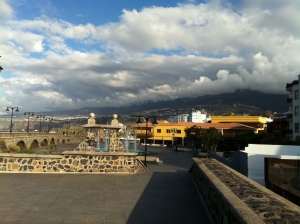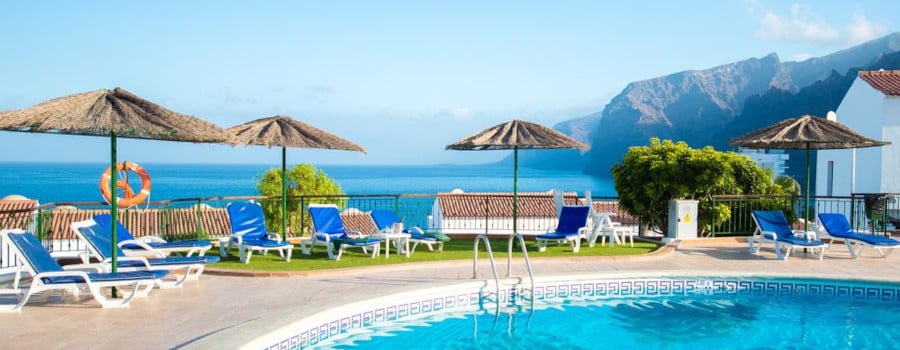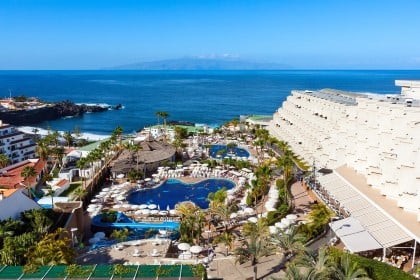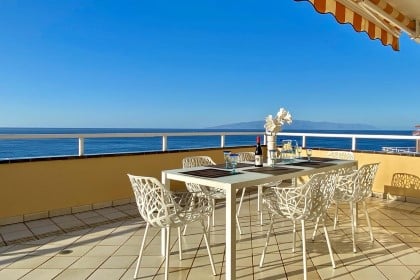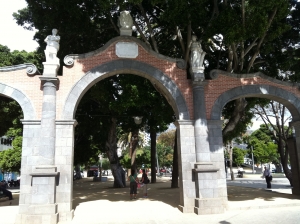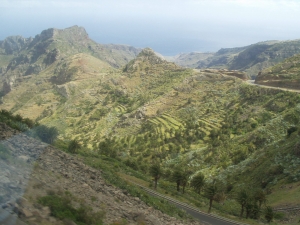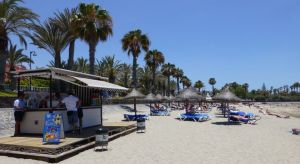
This article was by written Peter Allan
Peter fist visited Tenerife in 1982 staying in Puerto de la Cruz, and is now a habitual visitor to the island having become fascinated by its diversity, spending in excess of 8 weeks a year there. He has travelled all around the island staying in the lesser known resorts and towns, and has a particular interest in the history of Tenerife.
Loro Parque Tenerife
The very popular private zoo at Loro Parque is constantly adding new attractions. It all began as a parrot park where you could watch parrots performing, such as riding bicycles; I remember watching them way back in 1982. Loro Parque is now involved in important work to preserve the parrots habitat and endangered parrot species, and raises funds for conservation and research projects. It now features all sorts of animals such as chimps and gorillas, tigers, giant turtles and alligator.
There is an excellent dolphinarium and daily shows where the Dolphins will amaze you with their performance. The dolphin pools are the biggest in Europe, and can seat up to 1500 people and are the main event at Loro Parque.
There is also a Behind the Scenes tour where you can see where the dolphins train and the gorillas sleep.
There is also a Penguinarium, which is the world’s largest, where there is an authentic Antarctica eco system. Here live 3 different spices of penguin and they can be viewed through huge glass panels.
An aquarium housing over 20000 aquatic animal and plants, and an 18 meter shark tunnel where 7 different species glide above you close enough to touch is to many the highlight of their visit.
Loro Parque is located in the north of Tenerife near Puerto de la Cruz.
You can buy entry tickets to Loro Park in advance below.
Tenerife Money Matters
Currency: The currency of Tenerife is the same as the Spanish mainland and most of Europe. The Euro replaced the Pesetas in January 2002 and is divided into 100 cents.
100 cents = 1 Euro
Coins are denominated into 1, 2, 5, 10, and 50 cents. Notes are issued in 5, 10, 50, 100 and 500 Euro notes. The 500 Euro notes are no longer issued from the UK due to the use by criminal gangs.
Currency Exchange: You can easily change foreign currency and travellers cheques at banks in Tenerife. Also hotels, post offices and exchange bureaus will change your money; you must have your passport to exchange traveller’s cheques.
Banks: You won’t have a problem finding a bank in Tenerife; however you may find the service slow. Opening hours are 09:30 to 14:00 weekdays and 09:30 to 13:00 on Saturdays.
Credit card: All major credit cards are accepted throughout Tenerife and can be used in most shops, restaurants and hotels. There are also ATM machines in the towns and resorts available in a variety of languages.
Tipping and Gratuities: Service charges are sometimes added to the bills in hotels and restaurants so tipping is discretionary. A small tip can be left for good service. Tips are expected to be between 5% and 10%.
Getting to Tenerife
By air: You can get to Tenerife from many European counties direct by air. You can fly by cheap no frills carriers from the UK with the likes of EasyJet, Ryanair and WizzAir, also other airlines flying direct to Tenerife inclued British Airways, Aerligus and Jet2. Other charter airlines also operate from the UK including TUI and First Choice.
Almost all flights from the UK go to Tenerife South Airport (Reina Sofia), there is also an airport in the North of Tenerife which is serviced by British Airways scheduled flights from London Heathrow. North Tenerife airport mainly services flights from the Spanish mainland and most international flights go to Reina Sofia in the south.
If you are flying from North America, Australia or South Africa you will have to fly via Madrid on the Spanish mainland.
At Reina Sofia there are car hire facilities, buses and taxis. Playa de las Americas is about a 30 minute drive from the airport and Puerto de la Cruz is about 1 hour 45 minutes. Regular bus services run to all the resorts in the south and to Santa Cruz.
By Sea: The only ferry to Tenerife from Europe is from Cadiz on the Spanish mainland, although there are many cruise ships that stop by.
Tenerife Holiday Seasons
Tenerife has been described as the island of eternal spring. This means you can expect sunshine all year round and makes Tenerife a very popular destination for sun seekers from Northern Europe.
Tenerife is cooler in the winter months’ but it is still warm and sunny and this is when most tourists visit to escape the cold winter. December to February are considered high season, especially over Christmas and the New Year.
The months of May to October are also considered high season, and although Tenerife is further south than the Spanish mainland, it can be cooler due to the constant sea breezes of the Trade Winds.
The cheapest air fares are between the beginning of November and mid December, just before the Christmas rush, and between March and May. The Easter break will push up prices to the high season bracket.
Santa Cruz Carnival Tenerife
Santa Cruz Carnival Tenerife
Tenerife is bursting with fiestas. They range from town processions to romerias, which are festive pilgrimages leading from town churches to the country side. Religious and saint days are the most common reason for fiestas. The exception to this however is the Carnaval that greeting the arrival of spring, which goes back to pagan rituals.
The Carvaval is celebrated throughout the whole of Tenerife, but by far the largest and chaotic is the one held in the island capital Santa Cruz. The carnival festivities go on for 3 weeks but the mains events happen over one week with spectacular processions.
The Tenerife carnaval is comes second only to the Rio de Janeiro carnaval, and Diana Ross was spotted there a couple of years ago.
Santa Cruz Carnaval Schedule
A different theme is chosen every year, the first few days there are competitions, concerts, parades, events for children and gala a night the election of the carnaval queen. The grand parade takes place the following Friday and all night dancing continues for the following week.
The carnival is linked to the easter calendar and as such are different every year. The carnival queen is elected on the Wednesday before Shrove Tuesday and is a huge gala evening.
The elected carnival Queen is paraded throught the streets on the Friday before Shrove Tuesday when the carnival gets going with the Cabalgata Anunciadora.
The main carnival is on Shrove Tuesday in Sanata Cruz and ends with a spectacular firewoks display.
On Ash Wednesday the Burial of the Sardine takes place in santa Cruz and Puerto de la Cruz were me dress up as women.
On The Saturday after Ash Wednesday is the Junior Parade in Santa Cruz and the main carnival in Puerto de la Cruz.
Tenerife Carnival Dates 2013
Santa Cruz Main Carnival February 12th
Burial of the Sardine February 13th
Puerto de la Cruz Main Carnival February 16th
How to get to Santa Cruz
Santa Cruz in situated on the north eastern coast of Tenerife and can got to by road. Santa Cruz is about 50 minutes by car from the southern resorts of Playa de las Americas and Los Cristianos. The Titsa bus route 111 goes from Playa de las Americas bus station via Los Cristianos to Santa Cruz and takes about 1 hour 15 minutes.
From the northern resort of Puerto de la Cruz the bus route 102 and 103 go to Santa Cruz and the journey takes about 45 minutes.
Santa Cruz location is marked on the map below.
Other festivals in Tenerife occur throughout the year.
May:
Los Realejos
This fiesta dates back to 1676 and honours the patron of farmers, San Isidro
June
La Oratava
Here the residents of La Oratava celebrate Corpus Christi.
June
La Oratava
The Sunday after the Corpus Christi celebrations where farmers use cow driven carts and dress as magicians.
July
La Laguna
A procession features seven women, one for each of the Canary Islands. This is followed by a procession of floats, maypole dancing and others dressed in traditional dress and lots of noise and decorated streets.
15 August
Candelaria
This fiesta coincides with the \feast of Consumption. The pilgrims meet on 14th august and a grand ceremony takes place to commemorate the visitation of the Virgin Mary to the guanches. Then follows a procession to the Pozo de la Virgen were fireworks are let off.
August
Garachio
This fiesta originates from the 17th century plague when it struck Garachio. The town’s people appealed to Saint Roach who had devoted himself to plague victims in Italy in the 14th century. Every year the people of garachio converge at the chapel of San Roque, outside the town and take an image of saint Roach to Iglesia de Santa Anna in Garachio where Mass is held. A procession of the town’s folk then brings back the saint to his chapel.
30 November
Puerto de le Cruz and Icod de los Vinos
On the eve of St Andrews day the wine cellars of Tenerife are opened to welcome the year’s new wines. Some town’s celebrations are very noisy as everyone drinks the wine from the cellars.
Puerto de Santiago Tenerife Review
- Puerto de Santiago Beaches
- Puerto de Santiago Things to Do
- Puerto de Santiago Nightlife
- Where is Puerto de Santiago?
- How far is Puerto de Santiago from Tenerife South airport?
- Places To Stay In Puerto de Santiago
Puerto de Santiago Tenerife is a small quiet and relaxed beach resort, suitable for families and couples looking for a tranquil holiday. Elegant villas, apartments and hotels are set behind the beach. Puerto de Santiago does not set out to appeal to the mass tourist trade of the larger resorts such as Playa de las Americas further south.
Puerto de Santiago merges with Los Gigantes to the north which is a 20-minute walk away over the cliffs, and Playa de Arena to the south. If you don’t fancy the 20-minute walk, reliable bus services are running between the resort centres. Los Gigantes is another upmarket resort that gets its name from the enormous cliffs that tower over the resort.
Most of the holiday accommodation in Puerto de Santiago is appartment based with a handful of hotels.
Puerto de Santiago Beaches
Puerto de Santiago has a small beach, Playa de Santiago, of black sand with all necessary facilities. However, one of the best beaches on this part of the coast is a short walk away at Playa la Arena, the beach is made of exotic black sand. It is every bit as good as golden sand. This beach has been awarded the Blue Flag for water quality and cleanliness every year since 1989.
This part of the coast is otherwise mainly volcanic rock. There is a flag system for swimming conditions which you must adhere to, remember this is the Atlantic Ocean where you may experience strong currents.
Take a look at our Puerto de Santiago photos
Booking.comPuerto de Santiago Things to Do
Puerto de Santiago is ideal for families and mature holidaymakers looking for somewhere quieter than the larger resorts in the south of Tenerife. The resort is quite relaxing and relatively peaceful. There are cafes, bars and restaurants for lunch and dinner in the evenings with some small supermarkets and shops selling the usual tourist items. A short walk away is La Arena with more bars and restaurants and the charming Playa de la Arena beach.
There is also a pleasant traffic-free seafront promenade to walk along from Playa de Santiago heading towards Los Gigantes where there is a bar and restaurant on the oceanfront.
Organised fishing and pleasure boat trips operate from the harbour. The resort has excellent views out towards La Gomera some 20km off the coast of Tenerife.
Choose Your Hotel, Villa Or Apartment In Puerto de Santiago
Puerto de Santiago Nightlife
There are plenty of bars, some with live entertainment around the resort, and restaurants including tapas, pizza, Chinese, Mexican, Italian and Indian. On Calle de Hondura where the Hotel Barceló Santiago is located are more bars and restaurants, including the lively Route 66 bar with live music every night.
Where is Puerto de Santiago?
Puerto de Santiago is located on the west coast of Tenerife in the municipality of Santiago del Teide about 28 km from the resorts of Los Cristianos and Playa de las Americas.
Puerto de Santiago location is shown on our Puerto de Santiago map.
How far is Puerto de Santiago from Tenerife South airport?
The distance to Puerto de Santiago from Tenerife South Airport is approximately 43km by road, the transfer time takes about 45 minutes. The taxi fare from Tenerife South Airport to Puerto de Santiago will cost about 61 euros. There are no direct bus services from Tenerife South Airport to Puerto Santiago. However, you can get there by bus from the airport if you change buses.
How To Get To Puerto de Santiago From Tenerife South Airport.
Be aware that this part of Tenerife is very hilly and may therefore not be suitable for those who have mobility problems.
Places to Stay in Puerto de Santiago
Santa Cruz de Tenerife
Santa Cruz de Tenerife, better known as Santa Cruz, is the capital of Tenerife and of the Spanish province of Santa Cruz de Tenerife. Santa Cruz is far removed from the tourist resorts of the island. Santa Cruz is a major port and has population of about 200,000 residents, which is about a third of Tenerife’s population.
The city is bustling and modern and has the feel of a real Spanish city. The suburbs spread to the Anaga mountains to the north of the city, and spreads southwest wards to the Cumbre Dorsal.
Santa Cruz shares the governance of the Canary Islands with Las Palmas on Gran Canaria, and is one of the largest ports in Spain.
The city’s history goes back to arrival of the Conquistadors from Spain; it is on the coast at the site of the present day Santa Cruz that they landed in 1493.
Only a small minority of the tourist that come Tenerife visit Santa Cruz, as it is quite a way north east of the main tourist resorts, but this is a shame, as a visit to the city make a very interesting day out. It has a sea front promenade, shops, museums and leafy squares with cafes and terraced where you can enjoy a drink. Many cruise ships come to the port and so it has adapted for this tourist trade.
Santa Cruz enjoys the status of a ‘Free Port’ which means it can sell its goods duty free, so offers the shopper many bargains. Travel agents offer shopping trips, but these are usually only for half a day as the shops close at 13:00. You can hire a car to visit, but parking can be a problem, you should arrive early and use the underground car parks at Plaza Espania. You can also use the bus services that run from the resorts half hourly.
Santa Cruz is the venue of the biggest carnival outside of Rio de Janeiro. The Santa Cruz Carnaval is held every year on Shrove Tuesday.
Must See in Santa Cruz
Museo de la Naturaleza y el Hombre: history museum with extensive archaeological section and artefacts from the stone age Guanche people and ancient mummy's.
Iglesia de Nuestra Senora de la Concepcion: church with a beautiful interior and a hexagonal tower founded in 1502.
Mercado de Nuestra Senora de Africa: colourful market with a genuine Tenerife flavour selling fruit, meat, and vegetables. There is a busy flee market every Sunday in the surrounding streets.
Parque Municiple Garcia Sanabria: botanical gardens with trees, fountains, promenades and statues.
Parque Maritimo: sea water lido with pools, Jacuzzi, restaurants, and a beach.
Museo Militar de Almeyda: military museum with a section dedicated to Nelson's failed at attack on the city in 1797. On display is the canon (El Tigre) that allegedly shot Nelson in his arm, which was then amputated.
Where is Santa Cruz
Santa Cruz location on Tenerife is marked on the map below.
La Gomera
La Gomera is an island off the west coast of Tenerife and is the second smallest of the Canary Islands. La Gomera can be reached via Jetfoil in 40 minutes from Los Cristianos to San Sebastian de la Gomera.
People come to La Gomera for the tranquillity, so don’t expect much tourist activity. The only resort of any size is San Sebastian, there are a few beaches but these are small and made of black sand of shingle.
If you are going to hire a car be aware that the roads are very narrow and winding and the journeys can take longer than expected.
The island has two main types of visitor, day trippers from Tenerife and nature lovers who come in smaller numbers. Walking is very popular and there are extensive trails across the island. The centre of the island is covered by the Parque Nacional de Garajonay which was declared a World Heritage site in 1986.
The road heading north inland from San Sebastian rises steep and winding, where there are sheer drops down in to the valleys below. The peak of Garajonay is La Gomera’s highest point at 1487m and is often covered in mist and can be very chilly, but the conditions are superb for walkers and hikers.
The Parque Nacional de Garajonay is covered by a sub tropical Laura forest of the type that once covered the European continent in the Tertiary period.
The island is covered with a web of Barancos that spread from Garajonay to the coast. Much of the north and west of La Gomera is used for agriculture where bananas are the predominant crop, but the poor soil has always been difficult to farm.
La Gomera has its own whistling language that has survived from the pre Spanish days of the Guanche’s that was used to communicate across the valleys of the island. This language nearly died out but the children of La Gomera are now compelled to learn this in school.
Christopher Columbus stopped here to collect supplies on his voyages across the Atlantic discovering the Americas.
Unlike most of the other Canary Islands La Gomera has permanent flowing streams due to the relatively high rain fall.
All About South Tenerife
Until the 1960’s South Tenerife was for the most part deserted. Then tourism arrived, the potential was fully exploited, and mass development has continued ever since.
The south of Tenerife has a barren landscape and has very few scenic attractions, but the area’s big advantage is its weather. The coast of south Tenerife has almost year round sunshine, whereas inland can be wet and cloudy, and the Northern resorts of Tenerife don’t enjoy the same amount of sunshine due to cloud cover accumulating under mount Teide.
The difference between the lush subtropical north, and the barren south and centre can be quite a shock, but this climatic and geological contrast adds to Tenerife’s fascination.
The main resorts of the south west of Tenerife are Playa de las Americas, Los Cristianos and Costa Adeje. Los Cristianos was once a poverty stricken hamlet and barren volcanic desert, but Playa de las Americas and Costa Adeje were built as resorts from scratch. All three resorts have now merged to form a huge tourist urban playground of apartment blocks and hotels which sprawl up the hillsides.
There is a huge variety of restaurants, bars and clubs for the younger fun seekers. There are also a number of theme parks that are very popular with families and these can be easily reached via free shuttle busses. If water sports are your thing you won’t be disappointed as there is a full range of water sports available.
Further north along the coast are the quieter resorts of Los Gigantes and Puoto de Santiago, which are set against huge volcanic cliffs. The landscape inland is barren and uninspiring with a couple of notable exceptions at Masca and Barrance del Infierno, which are superb for walking. If you like walking, you can walk from the village of Masca, down the Masca gorge to the coast and then catch a boat along the coast to Los Giganties.
Many come to South Tenerife for the sunshine only, which is a shame as the North of Tenerife is full of culture and natural wonders.
All About North Tenerife
North Tenerife is without a doubt the most attractive part of the island, but it is cloudier and wetter than the arid south. These conditions are created by the trade winds from the Atlantic getting trapped by the mountain and rising and cooling to form cloud. This allows for the growth of subtropical plants such as bananas.
The scenery change from the south is quite dramatic, with lush vegetation and green mountain sides that bear testament to the rain fall this side of mount Teide.
This part of the island, especially around the Orotava valley and Puerto de la Cruz, is prone to cloud cover even in the summer months. In winter, particularly January and February, you could be seeing more cloud and rain than sunshine. So if you are looking for winter sunshine then you will be better off going to one of the resorts on the south east or south west coasts. If the sun is not important, this part of Tenerife has much to offer.
This northern strip of Tenerife is the most interesting for the visitor to Tenerife with low key resorts, historical towns, fishing villages, weird trees, banana plantations and rugged mountain terrain.
The main resort along the North Tenerife coast is Puerto de la Cruz, which is an interesting town that has preserved some of the charm of its old centre. It also suffers from modern tower block hotels that were built in the 1960’s tourist boom, but the old town is very pretty. It is also Tenerife’s second most important town after Santa Cruz.
The old town of La Orotava is situated up the hill side and has preserved its historical centre with its colonial houses and public buildings. The town is the best historically preserved in the whole of the Canary Islands, with marvellous houses and mansions built in the 17th and 18th centuries.
Icod de los Vinos is as its name implies is the wine making centre of Tenerife. It also has a Dragon Tree that is reputed to be over 1000 years old; the tree alone pulls in the visitors from all over the island.
Further west is the old capital of Garachico, which was Tenerife’s largest port until it was destroyed by a volcanic eruption in 1706. None of the original town remains from its commercial heyday, however it is today one of Tenerife’s most charming small towns.
Masca is truly one of the must visits on Tenerife. It is a tiny hamlet with no traffic and some absolutely dramatic scenery. You can hike down to the sea and back, which will take 6 to 7 hours!




